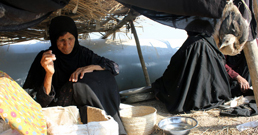The Shadegan marshes are located at the head of the Persian Gulf in the province of Khuzestan in south-west Iran. The largest wetland in Iran covering about 400,000 hectares, it is one of the 18 international wetlands listed by UNESCO. The marshes play a significant role in the natural ecology of the area. A combination of saline and fresh water, mud-flats and a very diverse vegetation provides the perfect environment for wildlife. It is an extremely important wintering habitat for a wide variety of migratory birds, and the northern part of the wetland is a vital freshwater habitat for many endangered species. About five decades ago, an area encompassing almost all of the main parts of the wetland was designated as a wildlife sanctuary, which also includes the most important site in the world for a rare species of aquatic bird – the marbled duck.
The natural environment and resources of the Shadegan marshes are not only essential for sustaining the ecology and the wildlife, but play a vital part in the economy of the area too. The five thousand inhabitants of the wetlands have learned through the ages how to make the most of what nature has provided for them. Having access to a wide variety of fish and birds, their main occupation is fishing and hunting birds. The dense vegetation provides fodder for their livestock, and milk from the oxen is used to make dairy products. Even the ox-dung is precious. It is collected, dried in the sun, and used as fuel for heating and cooking. The building material for houses, traditionally made of mud, palm tree branches and bamboo, comes from the marshes too.
But, as is so often the case in today’s world, the delicate balance of ecology, and with it, the traditional way of life and the livelihoods of the marsh people are under threat. The saline discharge from the sugar cane industry has affected the quality of water, leading to a change in the composition of the plant-life and damaging the local agriculture. The environmentalists have also repeatedly warned against the harmful effects of the leakage from sewage, industrial waste, and oil-pipes into the water. This, together with a reduction in the quantity of water as a result of its diversion to dams and irrigation systems, have already caused the fish population to dwindle. The livelihoods of the people of the marshes depend directly on the natural resources and any damage to the environment will have a detrimental effect on their lives.
This multimedia report takes us to the Shadegan marshes, where we meet its people and see scenes of their daily life.
This multimedia report was first published in February 2011.


